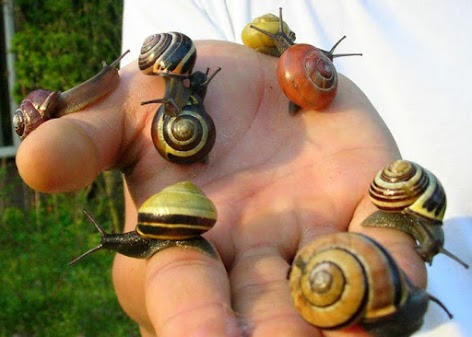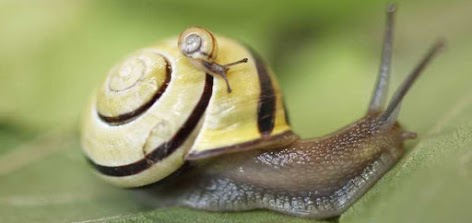Biodiversity research at a professional level
Challenge
 The effects of global warming on biodiversity are structural and calls for research to understand the nature and severity of those effects better. Since 1950, the average annual temperature in the Netherlands has increased by 1.5 degrees Celsius. Locally, urbanization can lead to an even greater temperature hike, as well as increased drought. The SnailSnap project attempts to answer the question as to how grove snails (Cepaea nemoralis) adapt to climate change and the effects of urbanization.
The effects of global warming on biodiversity are structural and calls for research to understand the nature and severity of those effects better. Since 1950, the average annual temperature in the Netherlands has increased by 1.5 degrees Celsius. Locally, urbanization can lead to an even greater temperature hike, as well as increased drought. The SnailSnap project attempts to answer the question as to how grove snails (Cepaea nemoralis) adapt to climate change and the effects of urbanization.
Shells of grove snails can appear in a wide variety of colors. This color is one of the determining factors in the snail's resistance to heat and drought. For example, snails with a lightly shaded shell will overheat less quickly when exposed to full sunlight. Does this also mean that, as an evolutionary effect of climate change and urbanization, grove snails, in general, attain a lighter color? This is one of the questions that the SnailSnap-projects seeks to answer.
91 possible classifications
 Participants in the project provide photos and location data of observations of grove snails, either through the SnailSnap app or through the website Waarneming.nl or one of its affiliated apps. Submitted photos are checked manually by validators, who first determine wether an observation indeed concerns a grove snail. If so, the observation is then labeled with a color classification. Classification first requires determining the actual color, which can be yellow, pink or brown. Next, the number of dark bands on the shell is assessed, as well as their position. Finally, validators determine whether or not the bands merge. All these findings combine into one of 91 possible color classifications.
Participants in the project provide photos and location data of observations of grove snails, either through the SnailSnap app or through the website Waarneming.nl or one of its affiliated apps. Submitted photos are checked manually by validators, who first determine wether an observation indeed concerns a grove snail. If so, the observation is then labeled with a color classification. Classification first requires determining the actual color, which can be yellow, pink or brown. Next, the number of dark bands on the shell is assessed, as well as their position. Finally, validators determine whether or not the bands merge. All these findings combine into one of 91 possible color classifications.
The correct classification of each observation is one of the challenges of the project. The app has been a considerable success, and in 2017 over 10,000 photos were collected. Over the coming years, thousands more are expected to be submitted each year. Each observation is classified by hand, which is time-consuming and can be difficult, as the color differences can be subtle. Dark pink snails, for instance, can be hard to distinguish from brown ones, especially to the untrained eye. This makes the work taxing, with a high turnover of validators as a result. New validators then need to be found, instructed and monitored, putting a strain on available resources.
Solution
 In this project, we aim to support the SnailSnap team by transferring part of the burden of classification to artificial intelligence. Using the database of previously submitted and classified SnailSnap photos, we aim to train a deep-learning model that can confidently recognize the different color classes, and implement it in the validation workflow, with the aim of automatically labeling new SnailSnap photos. One of the focuses will be the possibilities of more accurately distinguishing between classes that have a high similarity. The project will also include research into differentiating between Cepaea nemoralis and other snail species, thus further reducing the validators’ workload.
In this project, we aim to support the SnailSnap team by transferring part of the burden of classification to artificial intelligence. Using the database of previously submitted and classified SnailSnap photos, we aim to train a deep-learning model that can confidently recognize the different color classes, and implement it in the validation workflow, with the aim of automatically labeling new SnailSnap photos. One of the focuses will be the possibilities of more accurately distinguishing between classes that have a high similarity. The project will also include research into differentiating between Cepaea nemoralis and other snail species, thus further reducing the validators’ workload.
Additionally, automatic classification opens up the possibility of providing more direct interaction with citizen scientists. For instance, hooking up automatic identification to the SnailSnap app would make it possible to provide instant feedback on pictures of ‘wrong’ snails, thus also enhancing the educational potential of the app.
Outreach
SnailSnap is an initiative of Naturalis, Waarneming.nl and EIS Kenniscentrum Insecten. The SnailSnap app was developed by Zostera. In the coming years, SnailSnap will become part of EvoScope, a broad citizen science project investigating evolution in cities. The city of Leiden and the education department of Naturalis are two of the parties involved in EvoScope, among other parties.
Links:
- SnailSnap site
- SnailSnap app (Android)
Press:
- De stadsslak woont met deze hitte het liefst in een geel huis, Trouw, 28 July 2018 (in Dutch)
- Tuinslakkenonderzoek in de stad, Vroege Vogels, 28 April 2017 (in Dutch)